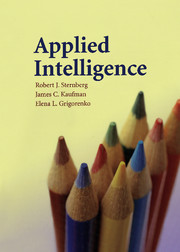Book contents
- Frontmatter
- Contents
- Preface
- 1 Views of Intelligence
- 2 The Theory of Successful Human Intelligence
- 3 Metacognition: Thinking with Metacomponents
- 4 Advanced Problem-Solving Steps
- 5 Cognitive Processing: Performance Components (I)
- 6 Cognitive Processing: Performance Components (II)
- 7 Logical Reasoning and Analysis of Arguments: Performance Components (III)
- 8 Inference and Inferential Fallacies
- 9 Knowledge-Acquisition Components
- 10 Coping with Novelty
- 11 Deciding for Creativity
- 12 Automatizing Information Processing
- 13 Practical Intelligence
- 14 Why Intelligent People Fail (Too Often)
- References
- Author Index
- Subject Index
6 - Cognitive Processing: Performance Components (II)
Published online by Cambridge University Press: 09 November 2009
- Frontmatter
- Contents
- Preface
- 1 Views of Intelligence
- 2 The Theory of Successful Human Intelligence
- 3 Metacognition: Thinking with Metacomponents
- 4 Advanced Problem-Solving Steps
- 5 Cognitive Processing: Performance Components (I)
- 6 Cognitive Processing: Performance Components (II)
- 7 Logical Reasoning and Analysis of Arguments: Performance Components (III)
- 8 Inference and Inferential Fallacies
- 9 Knowledge-Acquisition Components
- 10 Coping with Novelty
- 11 Deciding for Creativity
- 12 Automatizing Information Processing
- 13 Practical Intelligence
- 14 Why Intelligent People Fail (Too Often)
- References
- Author Index
- Subject Index
Summary
CLASSIFICATIONS
Classification problems require essentially the same set of performance components as analogy and series completion problems. Like analogies and series completions, classification problems can come in a variety of forms.
One form consists of a set of terms; one of them does not belong with the others. The task of the solver is to figure out which term does not belong with the others. For example, in the problem peso, pound, dollar, currency, rupee, the word currency does not fit with the others, because it is a superordinate term with respect to the other terms. A peso, a pound, a dollar, and a rupee are all units of currency. Another example is baked, roasted, deleted, mashed, french fried, and boiled. The word deleted does not fit, because all of the other terms described ways of cooking a potato. A third example might be flew, coup, through, boo, sew, and rue. The word “sew” is the only word in the list that is not pronounced with an “ooh” sound.
Another form of classification problem consists of a set of terms followed by a set of answer options. One example is lion, dog, giraffe, fox, (a) frog, (b) whale, (c) tuna, (d) wasp. Here, the task is to figure out which of the answer options belongs with the original set of terms. The best response to this problem is whale. The original terms are all mammals, and a whale is the only mammal of the possible choices.
- Type
- Chapter
- Information
- Applied Intelligence , pp. 147 - 188Publisher: Cambridge University PressPrint publication year: 2008



